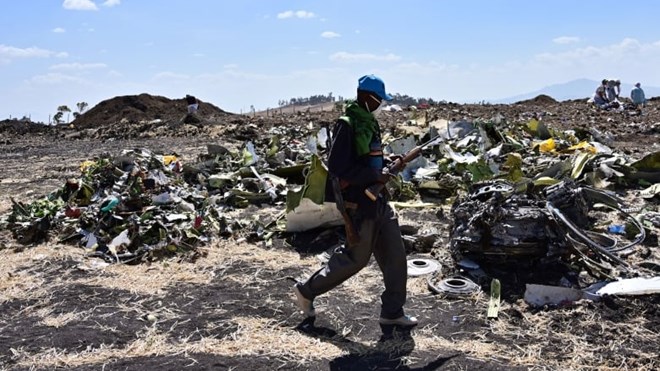
Thursday April 4, 2019
 A man hired to assist forensic investigators looking into the March 10 Ethiopian Airlines crash walks by a pile of twisted airplane debris at Hama Quntushele village near Bishoftu in Oromia region. (Tony Karumba/AFP/Getty Images)
A man hired to assist forensic investigators looking into the March 10 Ethiopian Airlines crash walks by a pile of twisted airplane debris at Hama Quntushele village near Bishoftu in Oromia region. (Tony Karumba/AFP/Getty Images)
The crew of the Ethiopian Airlines jet that crashed six minutes
after takeoff last month performed all procedures recommended by Boeing
when the plane started to nosedive but could not save it, according to
findings from a preliminary report released Thursday by Ethiopia's
government.
The report, based on flight data and cockpit voice
recorders on the Boeing 737 Max 8, was not released in full. Boeing
declined to comment pending its review of the report.
The Max 8
has been under scrutiny since a Lion Air flight crashed off the coast of
Indonesia under similar circumstances in October.Investigators
are looking into the role of a flight-control system known by its
acronym, MCAS, which under some circumstances can automatically lower
the plane's nose to prevent an aerodynamic stall. The plane has been
grounded worldwide pending a software fix that Boeing is rolling out,
which still needs approval from the Federal Aviation Administration and
other regulators.
The
Ethiopian Airlines jet crashed shortly after takeoff from Addis Ababa
on March 10 killing all 157 on board, including 18 Canadians.
Ethiopian
investigators did not specifically mention the MCAS, but recommended
that Boeing review "the aircraft flight control system related to the
flight controllability." They also recommended that aviation officials
verify issues have been adequately addressed before allowing the planes
to fly again.
Investigators could not yet say whether there is a structural
problem with the plane, Reuters reported. "We will analyze whether other
problems were existing on this aircraft," Amdye Ayalew Fanta, the head
of the investigation, told the news conference, adding this would take
between six months and a year.
In a statement Thursday, Ethiopian
Airlines said its pilots followed Boeing instructions. "Despite their
hard work and full compliance with the emergency procedures, it was very
unfortunate that they could not recover the airplane from the
persistence of nosediving," the airline said.
FAA to take 'appropriate action'
Boeing
is the focus of investigations by the U.S. Justice Department, the U.S.
Transportation Department's inspector general and congressional
committees. Investigations are also looking at the role of the Federal
Aviation Administration in the U.S., which certified the Max in 2017 and
declined to ground it after the first deadly crash in October.
The
FAA, which must certify the 737 Max is safe before it can go back into
the air, said in a statement that the investigation is still in its
early stages.
"As we learn more about the accident and findings become available, we will take appropriate action," the agency said.
The
statement did not say if the FAA would review the Max's flight control
system, as recommended by Ethiopian investigators, and FAA spokesperson
Greg Martin would not comment beyond the statement. Boeing is working on
improvements to the MCAS software that would make it less aggressive in
pointing the nose down and easier for pilots to disable. The FAA has
said it will review the software before allowing the Max to fly again.
But it wasn't clear whether the Ethiopians are seeking just that or a broader update in the Max's flight controls.
What
also isn't clear is whether the Ethiopian pilots followed Boeing's
recommendations to the letter in dealing with the system repeatedly
pointing the nose down.
The
pilots initially followed Boeing's emergency steps by disconnecting the
MCAS system, but for an unknown reason, they turned the system back on,
an official familiar with the crash investigation told The Associated
Press on Wednesday. The official spoke on condition of anonymity because
at the time, Ethiopian investigators had not released their preliminary
report. Boeing's procedures instruct pilots to leave the MCAS system
disconnected and continue flying manually for the rest of the flight.
Ethiopian
investigators did not address that issue at a news conference to
release the preliminary report, saying only that the pilots had done
what they were supposed to.
"The crew performed all the procedures
repeatedly provided by the manufacturer but was not able to control the
aircraft," said Minister of Transport Dagmawit Moges.
However,
Moges told the New York Times after the news conference that the pilots
turned MCAS on and off, but she couldn't say how many times. That will
be addressed in the final report, she said.
Report links two 737 Max crashes, analyst says
David
Hasse, an aviation analyst and editor of industry publication
airliners.de in Berlin, says it is significant that the report found
that the pilots followed the proper procedures, because that links the
case more closely to the Lion Air crash.
"What is special about
this case is that two crashes seem to have a very, very similar reason.
This is something that is very rare in aviation. The question is whether
the Boeing 737 Max should have been grounded after the Lion Air crash
and before the Ethiopian Airlines crash," said Hasse.
He
noted that crash reports are not meant to assign legal blame and that
it is too soon to know what the legal implications might be for Boeing,
but it clearly raises the pressure on the company.
"If pilots sit
there and follow the rules that have been given to them by the
manufacturer, then they should be able to rely on the fact that they are
correct," Hasse said.